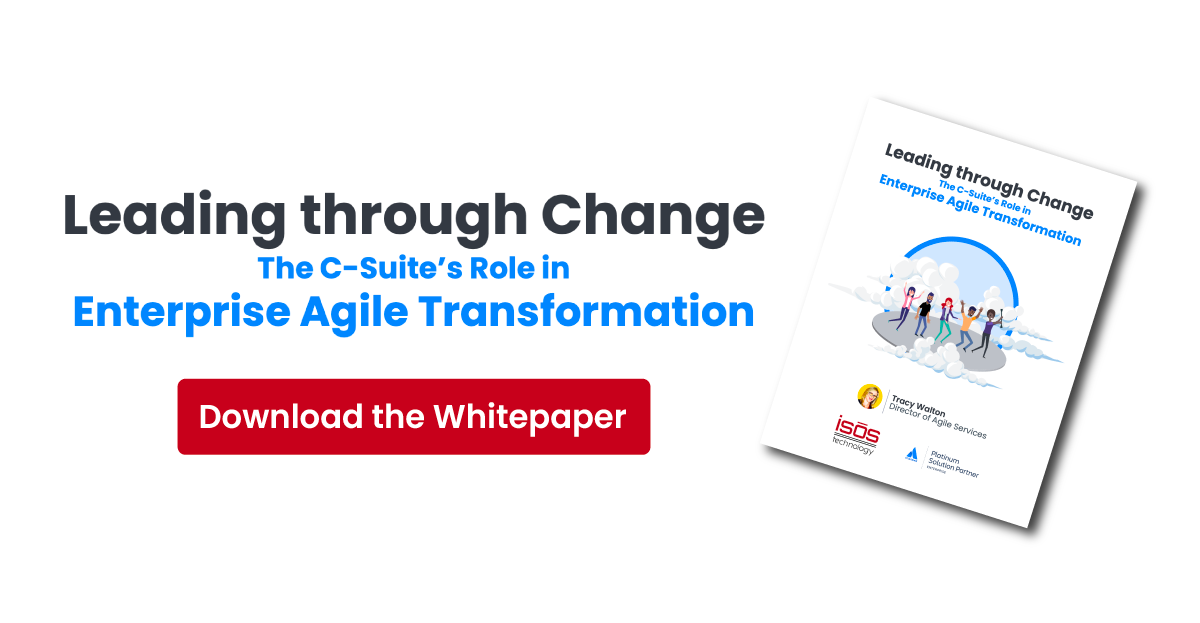
An agile culture embraces continuous improvement, but the only way to be certain that your organization is improving is to determine up front what success should look like and measure progress toward those goals. There are an infinite number of metrics to measure, though, and it’s easy to get bogged down in measuring too many things, or the wrong things—things that are not true indicators of success. John Doerr titled his groundbreaking book on OKRs, “Measure What Matters,” and in my agile consulting practice here at Isos Technology, I am a strong proponent of that philosophy. I often counsel my clients that the things that matter the most are workforce happiness, agile adoption, and the delivery of customer value.
I wrote briefly about agile transformation success metrics in my previous blog post, Agile Transformation: Three Key Factors that Determine Your Success, but in this post, I’d like to dig into each of these three areas a bit deeper...
Agile Success Metric #1: Workforce Happiness
A happy workforce is not a “nice to have.” In today’s competitive environment, it’s a business imperative. Study after study has shown that satisfied employees are better performers, and extrapolating, a happy workforce may help deliver a competitive edge. In my agile coaching practice, I encourage organizations and individual leaders at every level to focus, once again, on what really matters. It’s important to make it easy for people to be motivated, and that means emphasizing the positives, minimizing the negatives, and modeling behaviors that you’d like to see replicated. If you show people how things can be, they have a roadmap for getting there.
Agile requires cultural change, and if your organization’s employees are struggling, it’s a good indicator that the necessary change is not taking place. Companies should establish regular employee survey practices to take the pulse of their teams and identify both issues and successes. Think of these as employee Net Promoter Scores. Ask them how they feel about their work, their teams, and leadership, as well as if they have the tools and support systems they need to do their jobs successfully. Agile organizations embrace continuous improvement, so it’s also important that feedback be taken seriously, and that a process is put in place for addressing it.
Agile Success Metric #2: Agile Adoption
While agile transformation usually starts in development or IT, for it to be truly successful, it needs to be adopted across the organization, even in non-technical business principles. It’s important to measure whether teams are embracing it or fighting, where there is ambivalence, and where there is a lack of know-how or tooling. At an enterprise scale, it’s quite common to put goals and objectives around agile adoption for each division or department, and even for individual teams. These goals might start out as tactical; for example, is training being implemented and are systems and processes being put in place? As these are met and agile skill sets develop, these should move to more customer-focused, qualitative (rather than quantitative) goals structured around customers, even if those customers are internal.
Another advantage of setting goals around agile adoption: if you can identify some early successes, you can hold them up as examples for other teams to follow. Similarly, if you know where adoption is stalled, then you can explore what the blockers are and start resolving those issues.
One last thing I’ll note about agile adoption success metrics: organizations that adopt them will soon find that they serve as a catalyst for the other success metrics. If your organization is adopting agile best practices, people will by default be happier and the organization will be delivering greater customer value.
Agile Success Metric #3: Customer Value – Outcomes vs. Outputs
It almost goes without saying that the ultimate measure of customer value is success in the marketplace, but there’s a lot more to it than that. When I work with organizations in my agile consulting practice, many of them are measuring project performance—whether a given project was completed—and have yet to make the fundamental shift to measuring product performance, which is more outcome focused: how was the project received by the customer? An organization must embrace outcomes vs. outputs, as that is the true measure of value delivered.
Product performance means more than the outwardly-facing measurement of customer happiness with the product and their interaction with it, though. It should also entail the inwardly-facing measurement of the product as a system. This means looking beyond metrics around introducing new features and enhancements and putting metrics around less obvious things like addressing bugs. Both are important, and it’s important to strike a balance between the two. One way is to proactively define a starting metric (75% new features, 25% maintenance), measure it, and refine it as the business dictates.
How Isos Technology Can Help
As a premier Atlassian Platinum and Enterprise Solution Partner with Agile at Scale specialization, we are experts in change management for people and processes, as well as tool adoption to support agile practices. Our comprehensive agile consulting services help organizations increase customer and employee satisfaction, improve operations, and enhance their ability to deliver. We offer support for agile transformations, agile coaching, agile training and certification, agile software implementations, maturity assessments, and agile staffing.
To learn more about Isos Technology’s agile services, including Enterprise Agile Coaching, visit isostech.com/services/agile-services.
Sign up to receive more great content
Learn more about Atlassian and how Isos can help by signing up to receive our latest blogs, eBooks, whitepapers and more.

.png)












